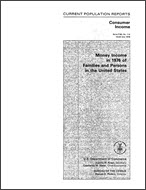Money Income in 1976 of Families and Persons in the United States
Money Income in 1976 of Families and Persons in the United States
Note
The income estimates compiled from the March 1977 Current Population Survey (CPS) were obtained from an expanded sample of households. The sample consisted of 65,500 housing units, approximately 10,500 more housing units than were used to develop income estimates from the March 1976 CPS. Further discussion of the sample expansion and other modifications to the income data can be found in the section, "New Procedures Used in the March 1977 CPS." This report also presents a discussion of two alternative methods of data presentation in the sections, "Head Versus Householder," and "Classification of Income Data by Principal Income Recipient." With the exception of these two sections, the term "householder" has been used in the text of this report in place of the term "head," which appears in the detailed tables.
Highlights
As indicated in the advance report on income, the 1976 median family income of $14,960 represented an increase of 9 percent over the 1975 median. After adjusting for the 6-percent increase in prices between 1975 and 1976,1 the median family income in terms of constant dollars increased by $450 or about 3 percent. Unrelated individuals had a median income of $5,375 in 1976, about 4 percent (or $210) higher in real terms than the 1975 median.2
The increase of 3 percent in real median family income between 1975 and 1976 marked a sharp reversal from the downward trend that had prevailed since 1973. Real median family income decreased by 4 percent between 1973 and 1974 and similarly by 3 percent between 1974 and 1975. However, the 1976 median family income of $14,960 was still lower, in terms of 1976 constant dollars, than the peak of $15,440 realized in 1973.
The increase in real median family income between 1975 and 1976 reflected the recovery of the economy from the recent recession and the abatement of high-level inflation. The improved position of the economy was indicated by a 6-percent increase in the real Gross National Product between 1975 and 1976.3 During the same period, the average annual unemployment rate for the Nation decreased from 8.5 percent in 1975 to 7.7 percent in 1976.4
White families had a median income of $15,540 in 1976, which represented a constant dollar increase of 3 percent above their 1975 median. In contrast, the 1976 median incomes of Black families ($9,240) and families of Spanish origin ($10,260) showed no statistically significant change in real terms from the previous year. In addition, sampling variability was too large to reliably determine whether there was an actual difference between the percentage changes in median income for White, Black, and Spanish families. Annual changes in real median family income since 1973 are shown by race and Spanish origin in table A.
The 1976 median incomes of families in the South ($13,420) and North Central ($15,940) regions both represented an increase in real terms of 4 percent. There was some evidence that the 1976 median family income in the West ($15,480) was 2 percent higher than the previous year. However, the median income in 1976 of families in the Northeast ($15,410) region did not show a statistically significant change in real terms.5
Of the 56.7 million families in the United States in March 1977, 10.1 million or 17.8 percent had incomes of $25,000 or more in 1976. There were 18.1 million families (32.0 percent) with incomes between $15,000 and $25,000, 11.5 million families (20.2 percent) with incomes between $10,000 and $15,000, 11.1 million (19.6 percent) with incomes between $5,000 and $10,000, and 5.8 million families (10.3 percent) with incomes below $5,000. (See table B.)
__________
1 The percentage increase in prices between 1975 and 1976 is computed by dividing the annual average Consumer Price Index (CPI) for 1976 by the annual average CPI for 1975.
2 The percentage change in real median income for unrelated individuals was not significantly different than that for families.
3 U.S. Department of Commerce, Bureau of Economic Analysis, Survey of Current Business, Volume 57, Number 3, p. 5.
4 U.S. Department of Labor, Bureau of Labor Statistics, Employment and Earnings, Volume 24, Number 2, p. 23.
5 The 2-percent increase in real median income for families in the West was not significantly different from the percentage change experienced by families in the other three regions.
A Note on Language
Census statistics date back to 1790 and reflect the growth and change of the United States. Past census reports contain some terms that today’s readers may consider obsolete and inappropriate. As part of our goal to be open and transparent with the public, we are improving access to all Census Bureau original publications and statistics, which serve as a guide to the nation's history.
Others in Series
Publication
Publication
Publication






